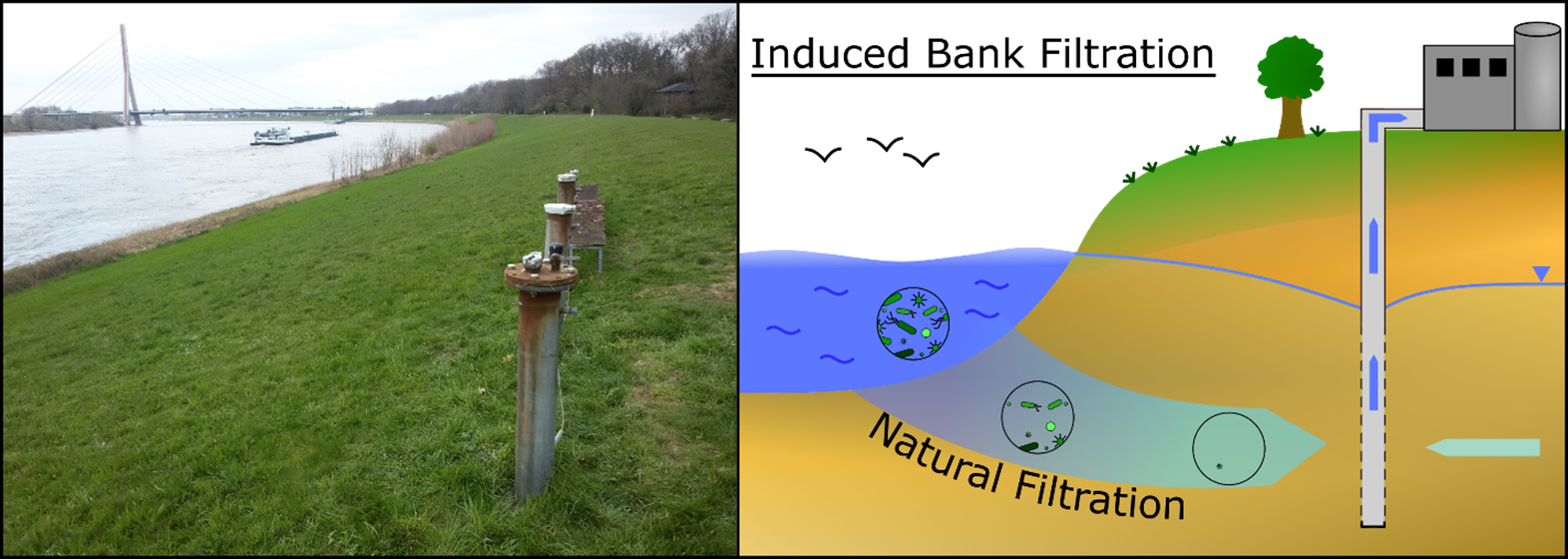February 01, 2023
Modeling How Pathogens Are Removed Using Riverbank Filtration
Identifying key environmental factors that impact pathogen removal in induced riverbank filtration.

Induced bank filtration is a reliable method for sustainable drinking water production.
[Courtesy Dustin Knabe, Technische Universität Berlin, Germany.]
The Science
Access to safe drinking water is vital for human survival, yet groundwater resources in many regions are increasingly stressed due to growing water demand. To mitigate this issue, induced riverbank filtration has been successfully implemented as a sustainable method for groundwater resource management. The removal of pathogens from groundwater during riverbank filtration is a complex process depending on various environmental factors such as floods and periods of drought, as well as pumping operations.
In this research, a multi-institutional team of researchers used modeling to investigate the effects of specific environmental conditions on pathogen removal in induced riverbank filtration. The team’s results demonstrated the transport behavior of human pathogenic adenovirus differed significantly from pathogen indicators such as somatic coliphages and coliform bacteria. However, reduced travel time primarily influenced the removal rate of coliforms and somatic coliphages in the aquifer. River level changes in rainy seasons and extraction rates at waterworks during dry periods affected travel time.
The Impact
Induced riverbank filtration is an important method for providing sustainable drinking water, but a variety of environmental conditions that affect pathogen removal can influence its effectiveness. By comparing the modeled transport behavior of human pathogenic adenovirus to the indicator species under changing seasonal and other environmental conditions, as well as differences in pumping operations, the team gained insights into the effectiveness of induced riverbank filtration for removing pathogens.
Summary
Water resource management is key to protecting water resource availability and quality, but pathogens remain a significant contaminant group that can persist after filtration processes. Pumping wells direct surface water through a riverbank where many contaminants are naturally removed as they infiltrate through the soil. However, pathogens such as viruses and bacteria can survive wastewater treatment processes and persist in surface waters. They are difficult to remove and remain a significant concern in induced riverbank filtration.
In this study, a multi-institutional team of researchers analyzed pathogen transport at an induced riverbank filtration site in Germany over 15 months. Water samples were collected from the site every 2 weeks and analyzed for human pathogenic adenoviruses, which cause respiratory, ocular, and genitourinary infections. The team also analyzed samples for pathogenic indicator species such as somatic coliphages, which are viruses that infect bacteria, and coliform bacteria. The research team then developed pathogen transport models to account for natural variations in temperature, oxygen content, river level, pathogen background concentrations, and operational variations in pumping.
The modeling results demonstrated that the transport behavior of human pathogenic adenovirus differed significantly from pathogen indicators. River level variations due to rainfall events were the primary factor controlling pathogen removal, whereas natural variations in temperature and oxygen content had minimal impact. Moreover, riverbed erosion during flood events was identified as a key process that reduced the removal efficiency of bacterial pathogens.
Principal Investigator
Dipankar Dwivedi
Lawrence Berkeley National Laboratory
ddwivedi@lbl.gov
Co-Principal Investigator
Eoin Brodie
Lawrence Berkeley National Laboratory
elbrodie@lbl.gov
Program Manager
Paul Bayer
U.S. Department of Energy, Biological and Environmental Research (SC-33)
Environmental System Science
paul.bayer@science.doe.gov
Funding
This material was supported partly by the Watershed Function Science Focus Area, which is funded by the U.S. Department of Energy’s (DOE) Biological and Environmental Research (BER) program, and the German Federal Environmental Foundation (Deutsche Bundesstiftung Umwelt DBU).
References
Knabe, D., et al. "Numerical Investigations to Identify Environmental Factors for Field-Scale Reactive Transport of Pathogens at Riverbank Filtration Sites." Advances in Water Resources 173 104389 (2023). https://doi.org/10.1016/j.advwatres.2023.104389.

